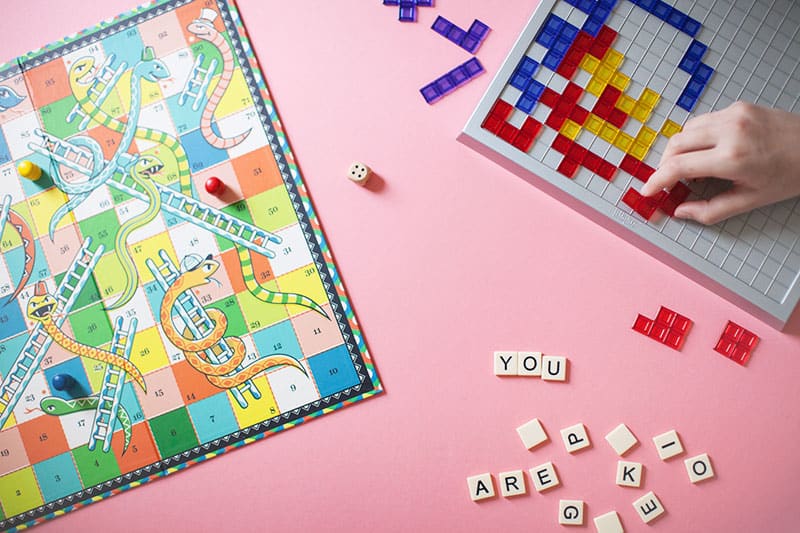
20+ Educational Games To Play With Your Kids
Written by Mindy White & Erin Feher
Photography by Photography by James Kicinski-McCoy
Time to break out the bard games! Kids love games, whether it’s playing with friends, family, or their own imaginations, and now that we all have days (and weeks!) to kill with our brood, it’s game time! Bonus: A great way to spark young creative minds is to introduce educational games for playtime. If it’s a board game with dice, a deck of cards, or even electronic media, they all do one thing—inspire kids to be strategic, creative, and fair. These days, there are literally thousands of games to choose from, but we think the classic ones rule the vote. We’ve gathered a list below of our favorite educational games to inspire a new tradition of weekly game night for you and the family!
Chutes And Ladders. Best for kids ages 3 to 5, and focuses on counting skills, sportsmanship, and taking turns. This classic game is ideal for young children who are just beginning to recognize numbers. We all remember playing Chutes And Ladders when we were kids. This childhood treasure challenges young minds to race to the top of the game board without sliding down. The game is so thrilling, it’ll even have your older kids on the edge their seats.
Bananagrams. Ideal for ages 7 and up, and uses 1-8 players. This is an exciting, fast, and educational word game that requires no paper, pencil, or board. Players race against each other to be the first one to complete a crossword grid using all of their letter tiles. Kids and adults everywhere both love this game, and it’s compact and easy to to take and play anywhere. Bananagrams is great for learning letters, spelling, reading, and building vocabulary.
Apples To Apples. Ideal for ages 7 and up, and uses 4-10 players. This game comes with so many laughs they won’t notice they are mastering their understanding of adjectives and nouns, onus loads of new words. There are two decks of cards: Things and Descriptions. Each round, the active player draws a Description card (which features an adjective like “Hairy” or “Smarmy”) from the deck, then the other players each secretly choose the Thing card (nouns) in hand that best matches that description and plays it face-down on the table.
Scrabble. Intended for ages 8+, and uses 2 to 4 players. Similar to Bananagrams, this classic game inspires learning by having each player put letters together, build words, add up their points, and win! This game has been played by millions around the world for decades, by sparking a word-on-word showdown that’s both thrilling and fun. Scrabble is also the winner of the Classic Award by Parent’s Choice Awards.
Cariboo. Best of ages 3 years and up. A recognition game. Cranium Cariboo is a whimsical treasure hunt game that makes learning fun with a focus on numbers, letters, colors, and shapes. This game includes both beginner and advanced cards, making players of all ages feel comfortable. Little ones love every minute of Cariboo, because every game is different. Each turn allows a chance to match exciting drawings, unlock secret doors, discover hidden treasure, and you never know where the treasure balls will be hiding!
Pandemic. For ages 10+. While this may hit a little too close to home at the moment, this quality game can be a great way to explain to kids what’s going on and how people are working behind the scenes to save us. In this game, four diseases have broken out in the world and it is up to a team of specialists in various fields to find cures for these diseases before mankind is wiped out. Players must work together, playing to their characters’ strengths and planning their strategy of eradication before the diseases overwhelm the world with ever-increasing outbreaks.
Memory. Recommended for ages 36 months – 6+, and can be played alone or with a small group. Yet another classic game, that helps to develop concentration and memory. Children learn about taking turns and matchmaking by collecting easy-to-remember card pairs of cute puppies, elephants, suns, and other recognizable objects. The player with the highest amount of matching cards wins.
Sorry! Intended for ages 6+. Players of all ages have been chasing each another around since 1934 with this family favorite. It’s a game of luck and determination that teaches patience and strategy. It’s known as the game of “sweet revenge,” since players can send each other back to the starting line to begin all over again. Sorry! not only teaches counting skills, but also gives a good lesson in sportsmanship.
Rummikub. Intended for ages 8+. This is a fast-moving, family-fun tile game that is super easy to learn for kids and grown-ups. Each player takes 14 tiles and goes onto make groups consisting of the same number but different colors (three or more of the same numbers in different colors), or the same color with different numbers (consecutive numbers of the same color). It’s a brain buster that teaches patterns, sequence, and numbers.
Blokus. Ideal for ages 5 and up. This award-winning family strategy game challenges creative thinking and healthy brain activity with a simple to understand concept of building. Players form images in their mind before placing the pieces on the board. Exciting for both kids and adults of up to four players, this competitive game is all about geometry skills and some major strategic thinking.
Battleship. Best for ages 7+ and 2 players. Another childhood game that inspires strategy in a duel of combat using math and fair play. Calling out targets and hitting or missing using red and white pegs, little ones hunt down, launch, and destroy their opponent’s ships while trying to hide and protect their own. Kids can have a head-to-head battle anywhere, as this game is compact and portable.
Mancala. Recommended for ages 6 and up. A game of judgment, strategy, and patience—some historians believe Mancala to be the oldest game in the world. The objective is to empty all of your stones before your opponent. The game is over when a player empties all six cups on their side. Mancala is a challenging but simple games for adults and children to learn! .
Chess. Recommended for ages 4 and up. This two-player strategy board game helps promote intellectual growth and develop essential critical thinking skills. It’s been played for generations and enjoyed by millions of people, of all ages. Another game that can be played virtually anywhere, with it’s compact, easy-to-setup board. Teach the kids young and you might just have another Bobby Fischer on your hands.
Connect Four. Intended for ages 6+ and 2 players. This thrilling table-top board game inspires both strategy and competition. Its simple set up and rules make it ideal for young ones, and yet, is exciting enough to keep older kids and adults eager to play. Simply connect 4 disks in a row without your opponent intercepting to win!
The Game Of Life. Intended for ages 8+. While the idea that the game of life is “won” by the player who ends up with the most money in the bank after retirement may seem off-putting, this old-school game is great way to introduce simple financial concepts, as well as get their wheels spinning about the future. And to hammer home the reality that kids cost money!
Let’s Go Fishing. Intended for ages 4+. This is like a mini carnival game, with 21 fish set in a spinning “lake” and players competing to catch the most. It’s all about hand-eye coordination, color recognition, and counting. Perfect for toddlers and young kids, although adults will even enjoy getting in on the fun.
Monopoly. Intended for ages 8+. This classic board game has kids counting cash, scheming real estate deals, and figuring out exactly what they can afford. It’s all about the long game with this one, so it teaches strategic thinking, budgeting, and bargaining.
Trouble. Intended for ages 5+. This simple make-it-around-the-board game is easy for anyone who has a basic grasp of numbers, counting, and colors, but the fun is in the popping die-flipper in the center. It’s a great game for siblings across age ranges.
Guess Who? Intended for ages 6+. This fun guessing game is perfect for little detectives. Players pepper each other with questions: Is your person wearing a hat? Does your person have blue eyes? in order to figure out their opponent’s mystery character. The first player to guess their opponent’s mystery character correctly, wins the game! This games helps build vocabulary, strengthen problem solving skills, and more.
Candy Land. Intended for ages 3+. This saccharine sweet games will have super plums and lolly pops dancing through their heads. Players encounter all kinds of delicious surprises as they move their cute gingerbread man pawn around the path in a race to the castle. No reading required, so it’s easy for even the youngest players.
Catch Phrase. Intended for ages 12+. This is electronic game was probably considered high-tech at it’s inception, but today seems quaint and fairly analog. The Catch-Phrase box is programmed with 5,000 words and phrases, and the goal is to try to get teammates to guess the word or phrase that appears on the screen by describing it any way possible—but do it fast! Don’t get caught holding the unit when the buzzer goes off because the other team will score a point. This game is all about vocabulary, quick thinking, and coming up with vivid descriptions.
Scattergories. Intended for ages 12+. This classic celebrates it’s 10th anniversary this year. It’s all about vocabulary and knowing your letter sounds. Each round starts with a word and phrase. For instance, the card says “bottles” and “things made out of glass.” You have two minutes to list as many things made out of glass as you can that start with the letters in the word “bottles.” For example, “bowl” for “B,” “orb” for “O,” “teacup” for “T” and so on. It’s a real brain booster for word-loving kids!
Azul. Intended for ages 8+. Azul was designed by the world famous, award-winning game author Michael Kiesling. Azul captures the beautiful aesthetics of Moorish art in a contemporary board game. Players compete as artisans decorating the walls of the Royal Palace of Evora. By carefully drafting the correct quantity and style of tiles, the cleverest of artisans plan ahead to maximize the beauty of their work (not to mention their scores!) while ensuring they wasted no supplies in the process.
For more at-home entertainment ideas, be sure to check out our roundup on 100 Screen-Free Activities To Do With Your Kids.
Share this story




